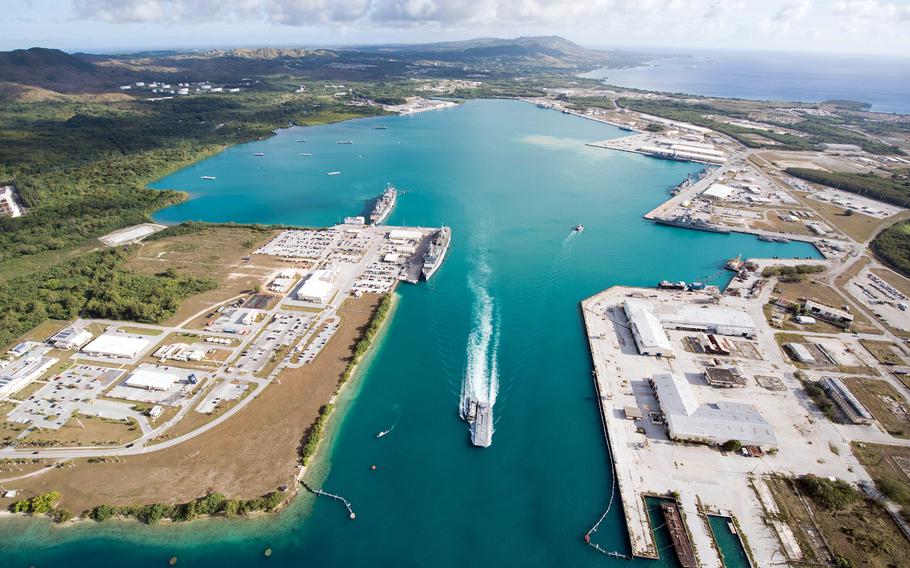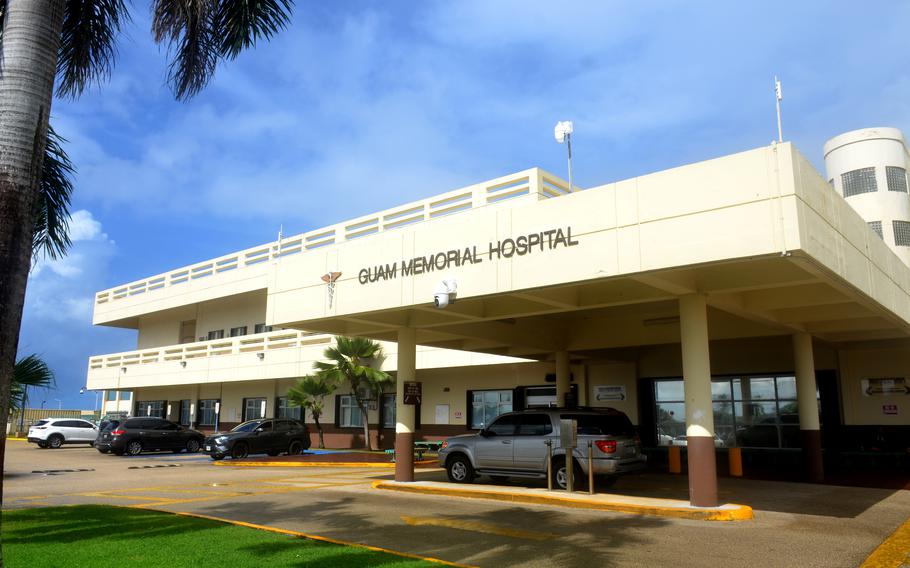
A vessel departs Apra Harbor at Naval Base Guam, March 15, 2018. (Stacy Laseter/U.S. Navy)
Building the $1.7 billion missile-defense system proposed for Guam may have significant consequences for the island’s housing, health care and natural environment, according to a draft environmental impact statement by the Missile Defense Agency.
The Enhanced Integrated Air and Missile Defense System will take approximately 10 years to construct and bring more than 2,000 contractors, Defense Department personnel and their families to Guam, according to the 678-page report released last month.
The effects on housing, health care and the environment could be “long-term and significant,” with sharp consequences for low-income and minority residents of Guam, according to the impact statement.
The missile-defense project coincides with plans to add nearly 5,000 more Marines to the recently established Camp Blaz and bring three more Coast Guard cutters to Naval Base Guam.
All told, the island’s already stressed health care system, housing market and at-risk natural environment are teed up for further delays, shortages and degradation, according to the report.
The DOD is “holistically reviewing” the project’s needs, including housing and medical facilities, with further evaluation expected in the future, Fred Hair, spokesman for the Missile Defense Agency, told Stars and Stripes by email Friday.
The agency aims to build 16 sites around the island to provide 360-degree protection against cruise, ballistic and hypersonic missile attacks by potential adversaries, including China, North Korea and Russia.
Guam, a 210-square-mile U.S. territory, could become an important hub in a regional conflict because of its location 1,500 miles west of the Philippines.
Building the missile-defense project will require approximately 400 workers annually over a 10-year period, and approximately 1,000 people to man it. Another 1,300 dependents are expected on the island, as well, according to the draft impact statement.
That influx represents just 1% of the approximately 168,000 population of Guam, but it coincides with the expected arrival of 1,300 Marines as the permanent garrison at Camp Blaz, and 3,700 Marines transferred from Okinawa as a rotational force, according to the report.
Together, they represent a 4% increase in Guam’s population, but the missile-defense system alone may further stress Guam’s already burdened health care system and housing supply.

Guam Memorial Hospital in Tamuning is one of just three hospitals on the island, the others being U.S. Naval Hospital Guam and the private Guam Regional Medical City. (Alex Wilson/Stars and Stripes)
The impact on Guam’s health care system is expected to be “long-term, major, and significant,” according to the report.
The island is considered a Medically Underserved Area by the U.S. Department of Health and Human Services, meaning it has a shortage of primary health care services.
Its remote, rural location hinders efforts to recruit medical specialists, forcing residents who need that care to travel at their own expense to Hawaii or the U.S. mainland, according to the report.
“The increase of 2,300 new residents could place an additional strain on Guam’s public medical resources, which are already experiencing a longstanding need for additional medical professionals and specialists to support the existing population,” the report states.
Most people affiliated with the defense project will have access to medical facilities at military bases on the island, but at least 274 contractors may rely on local health care services, according to the report.
That influx may also strain the island’s housing market. Guam is facing a significant shortage of affordable housing, and Gov. Lou Leon Guerrero in July established an Attaining Housing Commission to address rising construction costs and high mortgage rates.
To alleviate some of the strain, the DOD plans to bring the missile project’s personnel to Guam in phases and house most of them on military bases. Contractors and DOD civilian employees would live in surrounding communities.
All 16 missile project sites are on 900 acres of DOD property, but construction would destroy 269 acres of Guam’s native limestone forest, home to at least two threatened species.
The Mariana fruit bat and the Cycas micronesica tree are listed as threatened by the U.S. Fish and Wildlife Service; both are predominantly found among Guam’s limestone forests.
The missile project would remove approximately 4,900 Cycas micronesica trees, 1% of the remaining trees, the report states. The species’ population has declined at an annual rate of 8.1% due to other construction, climate change and various pests.
Impacts on the limestone forests, the Cycas micronesica trees and the fruit bats would be “major, direct, long-term and significant,” according to the environmental impact statement.
The Missile Defense Agency suggests mitigation efforts, primarily by improving a commensurate area of limestone forest elsewhere.
However, the impacts would remain significant even with successful mitigation efforts, according to the statement.